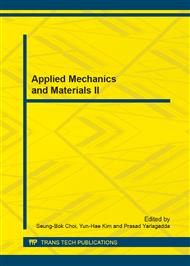p.519
p.524
p.531
p.535
p.539
p.543
p.547
p.553
p.558
FBG Sensor Application for GFRP Soil Nailing Pull-Out Test
Abstract:
The mechanical performance of GFRP soil nailing in the supporting structure is an important and difficult problem. By implanting the fiber bragg grating sensor (FBG) into GFRP soil nailing, pull-out tests were done on filed,and stress rules of soil nailing bar were determined.The more reasonable and effective force data of soil nailings were also gathered through FBG senor.Test results show that the tension of soil nailing gradually adds with external pulling force, the variation of tension is divided into two stages, the total pulling force is within 50kN, growing linearly with about 2.5% rate ,after that, its growth rate is approximately 50% to 60%. After the force exceed a certain value, the load is transmitted backward.FBG sensing technology overcomes the failure problem of traditional strain sensor,is a precise measurement method.
Info:
Periodical:
Pages:
539-542
Citation:
Online since:
December 2013
Authors:
Price:
Сopyright:
© 2014 Trans Tech Publications Ltd. All Rights Reserved
Share:
Citation:


